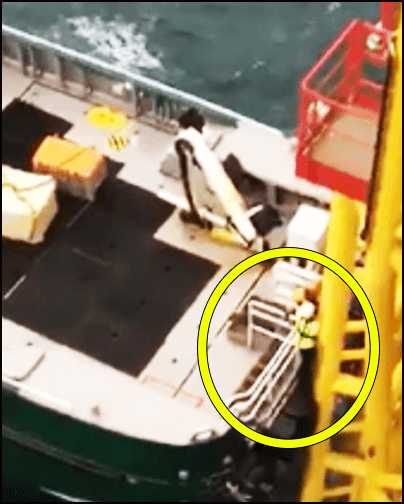-
What happened?
A group of technicians were transferring from a crew transfer vessel (CTV) to a jack-up vessel during marginal weather conditions.
The last technician was trying to find his balance and disconnect the self-retractable line (SRL) after stepping onto the jack-up vessel. Simultaneously, the CTV was struck by surge and drops.
The SRL engaged and the transferee became suspended, moving towards the boat landing. He was struck on the lower back when the vessel came back up but managed to climb on the jack-up.
The transfer was then stopped, and the CTV was emptied on to the jack-up vessel.
The boat landing on the jack-up vessel was not covered by CCTV, therefore the evidence was poor.

-
Why did it happen?
Lack of awareness due to not reviewing the documentation before starting the operation.
- The observed wave height was 1.6 metres (5.2 ft) when the transfer started.
- The organisation was not aware of 1.5 metres (4.9 ft) wave height limitation in the transfer procedure, therefore they sent out the vessel in a higher sea state.
The deckhand did not pull any slack on the SRL, meaning that the SRL activated instantly when the vessel moved.
The transferee was not able to disconnect from the SRL because he had to keep his balance, pull slack himself, and disconnect the personnel transfer capsule with one hand.

-
What did they learn?
Personnel should be aware of the transfer protocol to ensure that the most efficient and safe method of transfer is followed, particularly when there is a risk of weather affecting transfers. Re-brief if necessary.
Minimise personnel transfer by ladder onto CTV for in field transfers by putting personnel onto the walk to work vessels.
Hold meetings with CTV crews to discuss feedback from recent transfers to see what lessons can be learnt and what improvements can be made.
Ensure that the vessel provider procedure includes a step for pulling slack (in any transfer to and from vessel) when receiving transferee from boat landing.
Ensure that CCTV is working in all areas as intended.

-
Ask yourself or your crew
How can something like this happen here? What measures do we have in place to prevent it from happening?
How do you check if the weather conditions allow for safe operations when working offshore?
What improvements or changes should we make to the procedures, controls/barriers, or the way we work?

Add to homescreen
Content name
Select existing category:
Content name
New collection
Edit collection
What happened?
A group of technicians were transferring from a crew transfer vessel (CTV) to a jack-up vessel during marginal weather conditions.
The last technician was trying to find his balance and disconnect the self-retractable line (SRL) after stepping onto the jack-up vessel. Simultaneously, the CTV was struck by surge and drops.
The SRL engaged and the transferee became suspended, moving towards the boat landing. He was struck on the lower back when the vessel came back up but managed to climb on the jack-up.
The transfer was then stopped, and the CTV was emptied on to the jack-up vessel.
The boat landing on the jack-up vessel was not covered by CCTV, therefore the evidence was poor.

Why did it happen?
Lack of awareness due to not reviewing the documentation before starting the operation.
- The observed wave height was 1.6 metres (5.2 ft) when the transfer started.
- The organisation was not aware of 1.5 metres (4.9 ft) wave height limitation in the transfer procedure, therefore they sent out the vessel in a higher sea state.
The deckhand did not pull any slack on the SRL, meaning that the SRL activated instantly when the vessel moved.
The transferee was not able to disconnect from the SRL because he had to keep his balance, pull slack himself, and disconnect the personnel transfer capsule with one hand.
What did they learn?
Personnel should be aware of the transfer protocol to ensure that the most efficient and safe method of transfer is followed, particularly when there is a risk of weather affecting transfers. Re-brief if necessary.
Minimise personnel transfer by ladder onto CTV for in field transfers by putting personnel onto the walk to work vessels.
Hold meetings with CTV crews to discuss feedback from recent transfers to see what lessons can be learnt and what improvements can be made.
Ensure that the vessel provider procedure includes a step for pulling slack (in any transfer to and from vessel) when receiving transferee from boat landing.
Ensure that CCTV is working in all areas as intended.
Ask yourself or your crew
How can something like this happen here? What measures do we have in place to prevent it from happening?
How do you check if the weather conditions allow for safe operations when working offshore?
What improvements or changes should we make to the procedures, controls/barriers, or the way we work?
A group of technicians were transferring from a crew transfer vessel (CTV) to a jack-up vessel during marginal weather conditions. The last technician became suspended during the transfer. He received injuries in the lower back but managed to climb on to the jack-up vessel.













